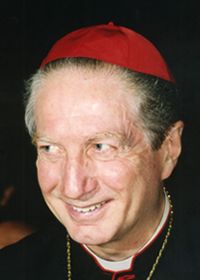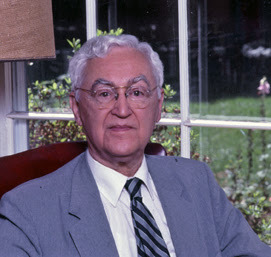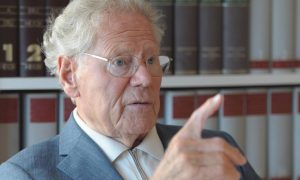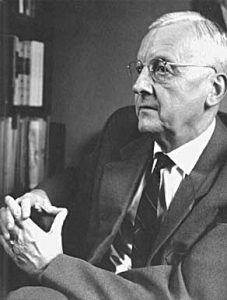Faleceu no dia 14, sábado passado, James Barr, um dos grandes biblistas do século XX.
James Barr
Radical academic whose incisive critiques challenged the orthodoxies of biblical theology
Professor James Barr, who has died aged 82, was one of those few academics to whom it is given to write a book that changes the way a whole discipline is pursued. The fact that the discipline was biblical theology and that the book was only the first of many brings the scale of his achievements into even sharper focus.
In the middle of the 20th century the biblical theology movement was at its height. Alongside its insistence that God revealed himself uniquely in the history of Israel, it also developed a substructure for its work on the nature of biblical language, whereby a major word, such as “holiness” or “justification”, gathered more and more allusions as it was used in different contexts until it became the bearer of a whole theological concept. A major dictionary could take many pages to unpack such a word, the whole made more complicated by the fact that it moved from the Hebrew of the Old Testament to the Greek of the New.
Barr’s book The Semantics of Biblical Language brought that whole juggernaut to a halt. Published in 1961, it came like a bolt out of the blue. In it he exposed the fallacy of thinking that a people’s mentality can be read straight off from their language, that the meaning of words is more determined by their ancient etymology than their current usage, and that peculiarities of use in one context can somehow be transferred to all uses everywhere thereafter.
This critique bore all the hallmarks of Barr’s later work – a devastatingly incisive exposure of faulty method with pertinent examples that sometimes caused great hurt to the individuals involved, focus on a linguistic topic of great importance for the proper interpretation of the Bible, and a concentration on analysing and correcting how people did things rather than a concern to show the results of proper method.
Born in Glasgow into a relatively conservative church family, Barr was educated at Daniel Stewart’s College in Edinburgh and then at the city’s university. His studies were interrupted by war service in the Fleet Air Arm of the Royal Navy, piloting torpedo bombers and participating in air-sea rescue missions. Following ordination, he served for two years as a Church of Scotland minister in Tiberias, Israel. His first academic post was as professor of New Testament in Montreal (1953-55), but he returned after that both to Edinburgh and to the Old Testament until 1961, the year in which The Semantics of Biblical Language was published. With hindsight, it is not surprising that he should have left for Princeton Theological Seminary in that same year. Not only were some of his closest colleagues on the receiving end of his criticisms, but by now he had become disaffected with the type of theology, inspired by Karl Barth, that then held sway there.
Returning to the UK in 1965 as professor of Semitic languages and literature in Manchester, he produced another major book, Comparative Philology and the Text of the Old Testament (1969), which was almost as influential as his first. For decades it had been popular to propose new meanings for Hebrew words on the basis of their cognates in related Semitic languages. A method that in itself could be fruitful had gone to seed, and this was just the sort of topic that Barr could analyse and for which he could suggest tighter methods and controls.
From Manchester, Barr moved to Oxford, first briefly to the Oriel chair (basically Old Testament) from 1976 to 1978, and then across to the Regius chair of Hebrew with a studentship at Christ Church (1978-89). By now his reputation was assured, and he travelled extensively, giving many named lecture series, and collecting more honorary degrees and fellowships than some colleagues considered decent. He continued to write influentially on a range of linguistic, biblical and theological topics, including fundamentalism, the nature of the early translation of the Hebrew Bible into Greek, the variable spelling conventions of classical Hebrew, the role of biblical narrative as story rather than mere history in theological construction, and more.
His interest in biblical theology continued unabated. After initially seeing hope of a sound replacement for the older approach in the developing ideas of canonical criticism, he then turned on its originators in Holy Scripture: Canon, Authority, Criticism (1983), again causing no little distress.
So much pioneering research and travel had its costs. Although he is remembered as an inspiring lecturer, undergraduate students were left too much to their own devices. Moreover, for a scholar of his eminence, he trained very few doctoral students. The chair in Manchester was discontinued after his departure, while in Oxford posts in Hebrew were cut drastically in the 1980s and the subject came close to being dropped. There is no doubt that Barr enjoyed Oxford, and many in Oxford enjoyed him. Contrary to the image one might gain from his writings, he is remembered at Christ Church as the most convivial of company. It was thus something of a surprise when he took (slightly) early retirement to move to Vanderbilt University in Nashville, Tennessee, where he taught from 1989 to 1998.
Of the several further books from this period, note may be taken of two in particular, in which Barr worked in a refreshingly positive manner: The Garden of Eden and the Hope of Immortality (1990) includes much interesting exegesis of the opening chapters of Genesis with far from conventional results, and Biblical Faith and Natural Theology (1993), based on his Gifford lectures, puts the case that the Bible includes full acknowledgement of the value of natural theology; this necessarily included a return to a renewed attack in vintage style on the theology of Barth.
Other late works dealt with the problem of writing biblical theology (stronger on critique than constructive proposal), and then, as something of a swan song, came a brief work in which the radical Barr suddenly appeared to be more conservative as he sought to take stock of where Old Testament studies had moved to during his career. This includes the remarkable confession that he could not accept a radical historical conclusion on theological grounds; such a confession would not have passed muster in 1961.
He died in California, where he and Jane, his devoted wife of more than 50 years, had settled in retirement. She survives him, as do their two sons and one daughter.
· James Barr, theologian, born March 20 1924; died October 14 2006
Fonte: HGM Williamson – The Guardian: 8 Nov 2006
The Rev Professor James Barr
Semitist whose technical approach to the Hebrew Bible changed the methods of biblical exegesis
James Barr, Semitist, biblical scholar, theologian and minister of the church: born Edinburgh 20 March 1924; ordained 1951 minister of the Church of Scotland; Professor of New Testament Literature and Exegesis, Presbyterian College, Montreal 1953-55; Professor of Old Testament Language, Literature and Theology, Edinburgh University 1956-61; Professor of Old Testament Literature and Theology, Princeton Theological Seminary 1961-65; Professor of Semitic Languages and Literatures, Manchester University 1965-76; Oriel Professor of the Interpretation of Holy Scripture, Oxford University 1976-78, Regius Professor of Hebrew 1978-89 (Emeritus); Fellow, Oriel College, Oxford 1976-78, Honorary Fellow 1980-2006; Student of Christ Church, Oxford 1978-89; Professor of Hebrew Bible, Vanderbilt University 1989-98, Distinguished Professor 1994-98 (Emeritus); married 1950 Jane Hepburn (two sons, one daughter); died Claremont, California 14 October 2006.
When James Barr’s The Semantics of Biblical Language was published in 1961, a new epoch began for all those who wished to study the languages of the Bible. That book came to be regarded as one of the leading publications in the field of biblical scholarship for the rest of the 20th century. It was often translated, but not only into Western languages – visitors to Barr’s home would sometimes be shown copies rendered into Indonesian or another exotic tongue.
The Semantics of Biblical Language appeared just as Barr was moving on from the Chair of Old Testament, Language and Theology at his Alma Mater, Edinburgh. He went on to become Regius Professor of Hebrew at Oxford University and ended his career as Distinguished University Professor at Vanderbilt University in Nashville, Tennessee.
He traced the relevance of his arguments for theology in his semi-popular Biblical Words for Time (1962). He then took some of his insights significantly further in 1968 with Comparative Philology and the Text of the Old Testament, in which he demonstrated an impressive competence in all the languages of the Semitic family, as well as expertise in correcting false procedures in linguistic argument. From that time onwards, a sounder methodological approach to biblical comparative lexicography and semantics had been established.
The breadth of Barr’s scholarship was remarkable, but he distinguished himself also with meticulous observations about the textual tradition of the Bible itself, in works like The Typology of Literalism in Ancient Translations (1979) and The Variable Spellings of the Hebrew Bible (1986). He was ranked among the foremost of Septuagint and Masoretic scholars.
Barr’s brilliance in Semitic linguistics and his technical approach to the Hebrew Bible and the Septuagint led to his penetrating critique of so-called canonical criticism, as for example in his Holy Scripture: canon, authority, criticism (1983). But this expertise advanced side by side with a series of books concerned with the wider world of theology. It is hard to think of any other scholar in this field who could combine vast erudition with profound insight and an exemplary and lucid style of English. Barr was deeply concerned with the role of the Bible in modern society, and he had the rare privilege of seeing several of his books become bestsellers.
After returning from one of his many research visits to North America, Barr felt constrained to launch into an intellectual debate with some of the standard arguments formulated by writers whom the British public labelled “conservative evangelical”. The appearance of Fundamentalism (1977), which was later to be followed by Escaping from Fundamentalism (1984), was misunderstood by some as a dispassionate attack against the grounds of their faith.
In fact, those who knew Barr (such as F.F. Bruce, a friend and colleague in Barr’s years as Professor of Semitic Languages and Literatures at Manchester University, 1965-76) knew that the impetus for the book was to set a conservative faith in an acceptable context for an intellectual enquirer. He had felt persuaded in this aim by some of his conversations with many younger biblical scholars who had found serious difficulties in this regard. When Barr debated the matter openly with his opponents one evening in Oxford at All Saints’ Church, not surprisingly the meeting was well attended.
At Oxford University, Barr was first appointed in 1976 to the Oriel Professorship but a little while later, in 1978, was invited to move to the Regius Chair of Hebrew. During those years he spent much time with a team of other scholars on preparing material for a new dictionary of the Hebrew Bible. He had inherited this task from some of his predecessors and progress had been unacceptably slow. Although the project after prolonged discussion was aborted by Oxford University Press, the files were handed over to the team in charge of the Revised English Bible, and so some of his work will have been embodied there.
Barr was born in Edinburgh in 1924, the son of the Rev Professor Allan Barr, Professor of New Testament at the Joint Congregational and United Free Church College in Edinburgh. Following studies in Classics and Theology, interrupted by Second World War service when he piloted torpedo bombers in the Fleet Air Arm of the Royal Navy, James Barr graduated from Edinburgh University in 1951. Ordained by the Presbytery of Dunfermline and Kinross in 1951, he served as Church of Scotland minister in Tiberias, Israel, for almost three years; then, after two years at Presbyterian College in Montreal, he was appointed in 1955 as Professor of Old Testament Literature and Theology at Edinburgh University.
There were those who regarded Barr as aloof, but in fact this was simply a natural Scottish reserve. He was a warm friend and a good colleague. Those who took time to get to know him well realised that what meant more to him than all his academic honours was his family. He held numerous honorary degrees and visiting professorships, and was elected to fellowship of the British Academy (1969), the Göttingen Academy of Science (1976), the Norwegian Academy of Science and Letters (1977), the Royal Society of Sciences, Uppsala (1991), the American Academy of Arts and Sciences (1993) and the American Philosophical Society (1993). But, as his elder son, Allan, said at his memorial service held in Claremont, California,
Probably none of his honorary degrees gave him as much happiness as his drives up the Delaware River valley to visit his daughter, his strolls through the streets of Claremont with his first grandchild, or his journeys to London to check on his seemingly endless proliferation of grandsons.
Even so, Barr showed himself devoted to scholarship in the last years of his life. As he approached the “three score and ten” time-line he published Biblical Faith and Natural Theology (1993), an important work that supports the idea of “natural theology” and argues that the concept is found in the Bible itself. This was followed by The Concept of Biblical Theology (1999), a massive overview of the progress of the important and ongoing debate about “Biblical Theology” in the 20th century. As if that were not enough, one year later we could read History and Ideology in the Old Testament (2000). Here, Barr demonstrates that he is well-read in the recent history debate, and he points to some of the weaknesses of the arguments used in the discussions.
During the last difficult months of his life Barr had to cope with the after-effects of a very serious fall suffered while attending a conference in Philadelphia. But it is typical of him that to the very end he was looking for new projects. Left on his desk was the beginning of a major work about prophecy.
Fonte: Hans M. Barstad – The Independent: 11 November 2006



